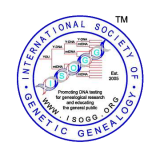Coefficient of relationship
From ISOGG Wiki
The coefficient of relationship is a measure of the degree of consanguinity (or biological relationship) between two individuals. The term coefficient of relationship was defined by Sewall Wright in 1922, and was derived from his definition of the coefficient of inbreeding of 1921. The measure is most commonly used in genetics and genetic genealogy.
In general, the higher the level of inbreeding the closer the coefficient of relationship approaches a value of 1, expressed as a percentage, and approaches a value of 0 for individuals with arbitrarily remote common ancestors.[1]
In human relationships, the value of the coefficient of relationship is usually calculated based on the knowledge of a full family tree extending to a comparatively small number of generations, perhaps of the order of three or four. As explained above, the value for the coefficient of relationship so calculated is thus a lower bound, with an actual value that may be up to a few per cent higher. The value is accurate to within 1% if the full family tree of both individuals is known to a depth of seven generations.[2]
| Relationship | Coefficient of relationship (r) |
|---|---|
| Identical twins; clones | 100%[3] (1) |
| Parent-offspring | 50% (2−1) |
| Full siblings | 50% (2−2+2−2) |
| 3/4 siblings or sibling-cousins | 37.5% (2−2+2−3) |
| Grandparent-grandchild | 25% (2−2) |
| Half siblings | 25% (2−2) |
| Aunt/uncle-nephew/niece | 25% (2⋅2−3) |
| Double first cousins | 25% (4⋅2−4) |
| Great grandparent-great grandchild | 12.5% (2−3) |
| First cousins | 12.5% (2⋅2−4) |
| Quadruple second cousins | 12.5% (8⋅2−6) |
| Triple second cousins | 9.38% (6⋅2−6) |
| Half-first cousins | 6.25% (2−4) |
| First cousins once removed | 6.25% (2⋅2−5) |
| Double second cousins | 6.25% (4⋅2−6) |
| Second cousins | 3.13% (2⋅2−6) |
| Third cousins | 0.78% (2⋅2−8) |
| Fourth cousins | 0.20% (2⋅2−10)[4] |
For information on calculating the coefficient of relationship when there is recent pedigree collapse in the family tree see the following two blog posts:
- Your DNA Guide. Pedigree collapse and your DNA matches. Your DNA Guide, 1 August 2019.
- Your DNA Guide. Calculating the pedigree collapse effect in your DNA matches. Your DNA Guide, 4 August 2019.
Resources
- Nolan Lawson's Relatedness Calculator The tool provides information on the percentage of DNA shared, the degree of relatedness and the relatedness coefficient
Further reading
- Calculation of the coefficient of relationship. From the Genetic and Quantitative Aspects of Genealogy website. (Retrieved from the Wayback Machine)
References
- ↑ Strictly speaking, r=1 for clones and identical twins, but since the definition of r is usually intended to estimate the suitability of two individuals for breeding, they are typically taken to be of opposite sex.
- ↑ A full family tree of seven generations (128 paths to ancestors of the 7th degree) is unreasonable even for members of high nobility. For example, the family tree of Queen Elizabeth II is fully known for a depth of six generations, but becomes difficult to trace in the seventh generation.
- ↑ By replacement in the definition of the notion of "generation" by meiosis". Since identical twins are not separated by meiosis, there are no "generations" between them, hence n=0 and r=1. See genetic-genealogy.co.uk.
- ↑ This degree of relationship is usually indistinguishable from the relationship to a random individual within the same population (tribe, country, ethnic group).
Licence
This article is licensed under the GNU Free Documentation Licence. It uses material from the Wikipedia article Coefficient of relationship.
